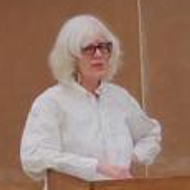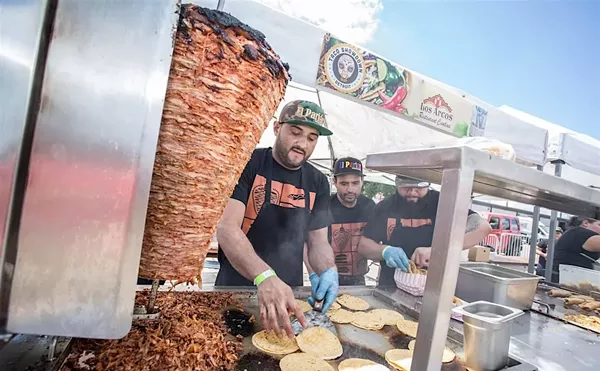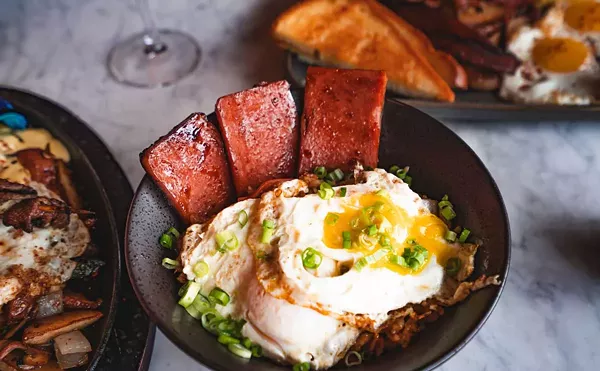
Audio By Carbonatix
[
{
"name": "GPT - Leaderboard - Inline - Content",
"component": "35519556",
"insertPoint": "5th",
"startingPoint": "3",
"requiredCountToDisplay": "3",
"maxInsertions": 100,
"adList": [
{
"adPreset": "LeaderboardInline"
}
]
}
]
Mexico's greatest living painter, Francisco Toledo, is seeking a million signatures against genetically modified corn. He is lending his prestige to the movement "because to contaminate our maize is to injure the heart of Mexico." If former Detroiters Frida Kahlo and Diego Rivera were in Mexico today, it would be easy to imagine them getting involved in this movement against the power of transnational capital.
First of all, because the legendary couple, in and out of the Communist Party, were always involved in radical causes, from land reform to supporting the Spanish Revolution. But also because food in abundance was central to the way they lived, and the traditional Mexican dishes they ate and celebrated with were based on centuries of cultivation of corn.
Kahlo and Rivera, at the center of Mexico City's circle of artists, intellectuals, and leftists, were always entertaining guests and always treating them to big meals that displayed up to a dozen dishes.
In solidarity with the poor, at their wedding feast Diego decreed that all was to be eaten with tortillas rather than knife and fork.
The Kahlo-Rivera attitude toward food was thoroughly tied up with their attitude toward Mexicanismo, their belief in exalting and promoting everything indigenous to their country, from art to clothing to cooking styles. (Frida's trademark flowing skirts and elaborate headdress were by no means typical of a woman of her class; she adopted the style of Zapotec women from Tehuantepec, Oaxaca, both as a political-cultural statement and to hide her damaged leg.)
Frida's kitchen in the house where she and Diego lived, the Casa Azul, was decorated in a traditional country style, with yellow-and-blue-tiled walls. She never ordered a modern stove, preferring that her cook use wood.
Food was presented in a style befitting an artist. A friend said, "Every day Frida made the table into a still life for Diego," with dishes and fruit arranged with a half-dozen bouquets from the market. The household pets were also invited to the table, making the still life a bit less still: a parrot might go picking among the dishes, a monkey might twine itself across Frida's shoulders, the skinny, bald Mexican escuincle dogs were underfoot. One parrot had the habit of squawking, "No me pasa la cruda" ("I can't get over this hangover").
A god and a sweet thing
Frida and Diego were married in 1929, when she was 22 and he 42, and she learned to cook from her immediate predecessor as Diego's wife, Lupe Marin. (Rivera married four times.) After the divorce, Lupe and their two daughters lived on the third floor of an apartment house she owned; Frida and Diego had the ground floor.
But Frida learned to make the meals Diego liked despite the psychological weirdness of the arrangement. Frida also owned her mother's cookbook, The New Mexican Cook, published in 1888.
Lupe taught Frida to take Rivera's midday meal to him in a covered basket while he was off painting murals, as campesina women would take meals to their husbands in the fields. In those early golden days of their marriage, Frida decorated the baskets with flowers and napkins embroidered, "I adore you." "She treated him like a god," remembered one friend. "He treated her like a sweet thing."
Frida's and Diego's division of labor in the kitchen was, of course, the traditional one. Although Frida could cook when she chose to, she was not, for the most part, slaving over a hot stove; the two saw no contradiction between their communism and their servants. She oversaw the ordering and cooking of the food; he ate it, and weighed more than 300 pounds.
Later, in the 1940s, the couple moved to the Casa Azul, which was Frida's childhood home. Her biographer Hayden Herrera describes a typical eating day: Breakfast would be leisurely, with Frida or an assistant reading the newspaper aloud to Diego, who did not want to tax his eyes. Afterward, Frida would either paint or go to the market, and Diego would go off to work. If he'd been drawing in the marketplace — where he often went to observe the poor who were his most important subjects — he would come home for comida, the main meal of the day, perhaps bringing an ingredient for the cook to incorporate.
If Diego stayed at his studio through lunchtime, Frida would send or take over a blue pewter dinner pail divided into compartments, each holding a different dish and topped with warm tortillas and bread and with cut fruit and flowers artistically arranged.
In the afternoon, Frida might paint or go to the movies or to a boxing match. In the evenings the two would share a late supper of hot chocolate and pan dulce — the sweet breads sold in a dizzying variety of shapes. (Visit Detroit's La Gloria Bakery or Mexicantown Bakery for some samples.)
Self-portrait still-lifes
For Kahlo, domestic tasks took on the nature of an art project. Her stepdaughter Guadalupe Rivera remembers, "For Frida, setting the table was a ritual."
The food itself was treasured for its beauty as well as for its flavors. After her self-portraits, most of Frida's other paintings were still lifes. Herrera writes, "As always when painting objects other than herself, Frida made her fruits look like her. Her melons and pomegranates are cut open, revealing juicy, pulpy centers with seeds, making us remember her wounded self-portraits and her association of sex with pain. Sometimes she peels off just a little of a fruit's skin." Herrera describes one still life, commissioned for the president of Mexico, that was so blatantly sexual that its shocked intended purchaser sent it back. Other paintings from the 1940s "transformed tropical-looking plants into male and female genitals."
In 1932, Rivera visited Greenfield Village, at the invitation of Henry Ford, and was captivated by its collection of "mechanical wonders." He was amazed by the kitchen in Ford's home, "so highly mechanized there was almost nothing in it to be done by hand," like being "surrounded by a mechanical orchestra." Ford explained his view that human sensitivity and intelligence should not be wasted on food preparation, although he allowed that they could be spent on enjoying the end result. Rivera did not say whether he agreed that cooking was a waste of time.
Of course, one of Rivera's most potent themes was how the humble gained their daily bread, and his murals are crowded with such scenes. He depicts "labor conceived as a rhythmic dance," as his biographer Bertram Wolfe describes it. In the Detroit murals and in others, when we see people at work the feeling is that of men joined in a common project, bodies moving, muscles working, rather than of ruthless exploitation by those workers' bosses.
In fact, Rivera had nothing but praise for the assembly line. He thought of Ford's factories as a "wonderful symphony," a "new music." The genius Ford was "a true poet and artist, one of the greatest in the world," who had brought together "millions" of workers — miners, railroaders, teamsters, factory workers — "so that man, space and time might be conquered, and ever-expanding victories be won against death." He only regretted that he did not feel free to write a book singing Ford's praises, for fear of being accused of "flattering the rich."
Though he mouthed and often painted the slogans, Wolfe says, Rivera was a better populist than he was a Communist.
In Detroit
Their year's sojourn in cold Detroit, 1932-33, was not a happy one for Frida, with none of the comforts of home and with Rivera thoroughly engrossed in painting the courtyard of the Detroit Institute of Arts (the original commission specified that he would be paid $100 a square yard). Biographers say Frida ate a lot of hard candies and nougats (similar to cajeta, caramelized goat's milk) and that she found only three foods in the bland American diet that she liked: malted milk, applesauce, and American cheese.
Eventually, though, she discovered grocery stores in Southwest Detroit where she could buy the ingredients she needed, though she was frustrated by her apartment's electric stove. She once again prepared baskets to take to Rivera, as he painted at the DIA. There he was often watched by unemployed Mexican workers, and the couple would share the food as they sat on Coca-Cola boxes. One of those workers, José de Jesus Alfaro, remembers, "I went to the Institute to get something to eat."
Still, Rivera's food life in Detroit was fraught with tension. His doctor ordered a rigorous diet; he was allowed each day 12 citrus fruits, two vegetable salads without oil, a liter of vegetable juice, and thyroid extract. Each night he was to bathe in Epsom salts. Rivera lost 100 lbs. When Frida returned to Detroit after a six-week visit to Mexico, she didn't recognize him in his borrowed clothes. Wolfe reports that this drastic regimen was followed by years of glandular problems, irritability, and hypochondria. In 1936, a specialist ordered Rivera to be "reinflated," and he returned to his accustomed size.
Feasting till the end
Even when Frida became very ill, a long-term result of the 1925 trolley accident that left her crippled, she continued to savor eating well. She spent 1950 in a hospital in Mexico City, and her visitors brought big baskets of moles and enchiladas, watched movies, and drank tequila. Her lifelong friend Olga Campos remembered, "There was a party on in Frida's room every day."
As her pain grew and her right leg was amputated, Frida turned more and more to alcohol and to narcotics such as Demerol. She had long carried a flask of cognac or liquor disguised in a perfume bottle, and was known for her capacity to drink men under the table. In 1938, she wrote to a friend that she had cut down (for the present) on alcohol: "I drank, because I wanted to drown my sorrows, but now the damned things have learned to swim, and now decency and good behavior weary me!"
In her last year, decency and good behavior were far from Frida's mind. Her life was a misery, with oceans of pain and with Diego staying away for days at a time. And yet she threw a big party for her birthday, with 100 guests, turkey with mole, chiles, tamales, and atole.
Self-expression
Rivera and Kahlo lived life large and were larger than life. They lived their contradictions in the public eye, switching their allegiance from Stalin to Trotsky and back again, and from lover to lover, in Kahlo's case of both genders. Rivera was a Mexican nationalist who relished his time in the United States; he was a believer in a pre-Conquest paradise who was fascinated by machinery and automation. They were socialists who rubbed shoulders with Fords and Rockefellers.
Their political adventures, their scandalous affairs, their love of all things gorgeous and bounteous and over-the-top are not legends, created because the world loves a good telenovela. Rivera and Kahlo were the real deal, creating their lives as art, as artists.
As I stood in a long line, in January, to enter the Casa Azul, now a museum or shrine, I asked Adriana Morales, who was standing behind me with her son and husband, what Frida Kahlo meant to Mexicans. Her face lit up. "She was one of the most important women in Mexico," she said. "At a time when women didn't have rights, she fought for her rights."
So was she a feminist? Morales considered. "No, it was more that she fought for her right of self-expression as a person."
In that, of course, Kahlo succeeded as few other women of her time and as no others of her place. Her favorite subject was herself, and she managed to take her considerable personal pain — both physical pain caused by a horrific traffic accident and psychological pain caused by her tempestuous relationship with Rivera — and turn it into art that millions, women in particular, have embraced.
Jane Slaughter writes from Oaxaca, where she was the lucky person to receive the Jesus slice on Three Kings' Day. Biographical research was deliciously aided by the following works: Frida's Fiestas, by Guadalupe Rivera and Marie-Pierre Colle; Frida, by Hayden Herrera; My Art, My Life, by Diego Rivera; Frida Kahlo: An Open Life, by Raquel Tibol; The Fabulous Life of Diego Rivera, by Bertram D. Wolfe; Mexico: The Cookbook, by Margarita Carrillo Arronte.






